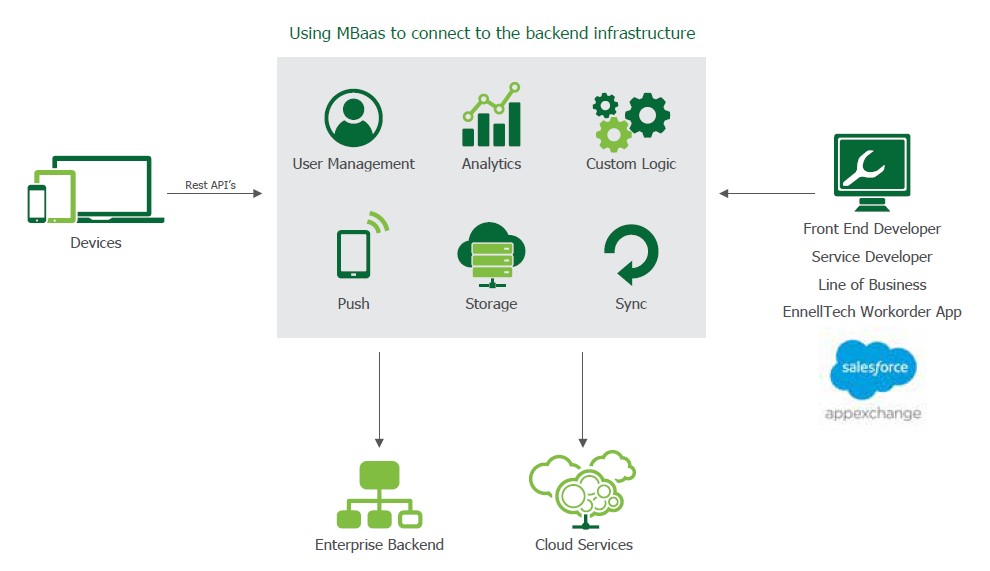Mobile Backend as a Service (MBaaS)
Overview
As a department chief or IT manager, one of your main tasks currently is probably to implement a method of enabling the company work force to use mobile devices to access relevant IT systems. There is also a desire to enhance the current IT systems by enabling their use both on-line and off-line through relevant apps running on mobile devices.
It’s easy to get caught up in the idea that all you need to do is to create a mobile app and your work is done, the company will reap enormous profits and all will be right in the world. The truth, of course, is that there’s much more to consider, including such things as different mobile architectures, backend services, and analytics. Industry analysts state that 80% of the work is in the integration of backend systems.
EnnellTech Solution
EnnellTech have been providing IT companies with methods of mobilising their enterprise data since 2004. Specialising in retail and manufacturing initially, EnnellTech’s major area of expertise since 2006 has been in the aviation sector.
One of our products, Skypaq, enables flight crew and technicians of aircraft to communicate seamlessly using our mobile technology skills. This information is transmitted immediately from EnnellTech servers to core airline IT systems enabling real time management of aircraft.
EnnellTech is now providing our “Mobile Backend as a Service” (MBaas) solution to our non-aviation clients well.
This model provides web app and mobile app developers with a way to link their applications to the enterprise back office systems through API’s (enable programmatic interaction to backend systems) and cloud storage.
As an option, our partnership with Salesforce will ensure that Salesforce users will have the ability to download our application, from App Exchange on the Salesforce platform. This will also enable Skypaq to quickly provide backend integrations for our workorder solution.
Considering Mobile Architectures
Clients
Users expect apps and services that have a familiar look and feel on any platform. Cross-platform capability for iOS, Android, and Windows is a key consideration.Integration
Users want mobile access just like they have on their desktops – to the HR System, financial system, company directory, talent management, expense apps, and so on.Security
Enterprise and security go hand in hand. Aside from strong encryption, you’ll want to incorporate your existing security infrastructure.Standards
Use open standards if possible or if required use proprietary protocols from backend systems if applicable.Introducing Mobile Backend as a Service (MBaaS)

EnnellTech’ s MBaaS solution abstracts the server-side infrastructure so your developers don’t have to concern themselves with how the server is structured. Instead, developers simply assemble the building blocks of the app and write the code that connects them to the backend infrastructure as services as shown in Figure 1.0 above.
The result is that the developers can concentrate on creating an app that looks and functions as users expect.
MBaaS provides the platform from which backend service developers can connect to backend systems (such as human resources or finance) and expose services from those backends as mobile friendly APIs. Backend service developers create the APIs that are shown in the API catalogue. Mobile app developers browse the API catalogue for the needed functionality. Mobile app developers and backend service developers collaborate to define the APIs needed to create a mobile app with access to the backend systems.
MBaaS also makes cross-platform app development easier because developers don’t have to create separate backend systems for each platform. Instead the same services can easily be provided to all clients, no matter what type of device or OS might be involved. The bottom line is that MBaaS will save you money and produce better results.
Business Model – Pricing
EnnellTech provides clients with flexible pricing models depending on their requirements. We will carry out a site visit and have user workshops with your relevant IT department to produce a solution best suited for your enterprise’s requirement. From this we will develop a pricing model that suits you.
The two main options usually are:
- Freemium – Clients receives a certain amount of free active users or API calls per month and pays a fee for each user or call over this limit.
- Flat Fee – Set pricing fee per month that covers all the users’ requirements
